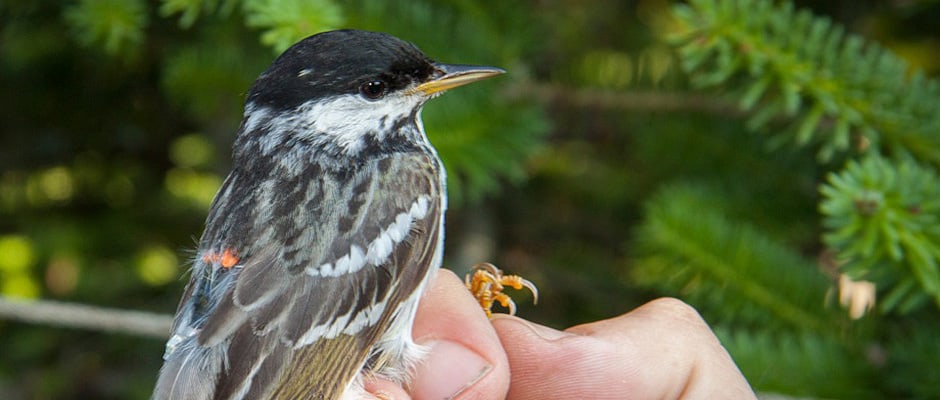Share this article
Tiny Songbirds Make Epic Trans-Atlantic Migration
A half-ounce songbird makes an epic three-day flight while migrating between eastern Canada and the U.S. to Venezuelan winter grounds, according to a new tracking study.
The blackpoll warbler (Setophaga striata) has long been thought to barrel straight across the Atlantic Ocean in its migration to southern climes, but scientists have finally confirmed it with the help of new tracking devices small and light enough to equip on the birds.
“What makes this quite amazing is that blackpolls weigh 12 grams — the weight of a couple of loonies [a Canadian one-dollar coin],” said Ryan Norris, a biology professor at the University of Guelph and the senior author of a paper released yesterday in Biology Letters.
Indirectly, people have assumed the birds travel straight across the ocean on their way south for a number of reasons. During bad weather conditions, sailors in the ocean have noticed the bird often lands on their ships in certain parts of the Atlantic. Radars also picked up evidence of warbler-sized birds setting due south from Nova Scotia in Canada but it was difficult to confirm whether the blips were actually blackpolls. The last clue, according to Norris, was “the lack of observation evidence of blackpolls in the fall in the Southeast U.S.”
“Where do they go?” he asked.
The Things a Bird Does for Science
New technology in the form of miniscule geo-locaters that weighed less than 0.01 ounces was harnessed and equipped to 37 birds departed from Vermont and Nova Scotia, Canada.
The devices were too small to live-transmit location data, so they had to be recovered once the birds returned from wintering grounds in Venezuela. But blackpolls aren’t particularly loyal to their summer breeding areas, so it wasn’t easy for scientists to find their avian research assistants. Only five birds were recovered — two in Nova Scotia and three in Vermont.
“It is like searching for a needle in a haystack in a sense,” Norris said.
All five of the devices they recovered showed the birds had made three-day journeys south across the ocean, taking a brief, weeklong pit-stop in Haiti, the Dominican Republic or Puerto Rico before continuing to Venezuela. The maximum total distance of the birds’ flights was about 1,740 miles, Norris said.
One of the birds wasn’t quite as brave about the open ocean flight, though. Data showed it didn’t leave landfall until somewhere around Cape Hatteras. Norris said that there may be variation, since they only recovered the five devices. Part of this could have been that while the locaters are tiny, they may have weighed enough to affect the birds’ journeys.
But blackpolls occur fairly commonly across the Boreal Forest, from Alaska all the way to the U.S. Northeast, meaning some birds may travel even farther, including pit stops on the North American continent. Norris said plans are in the works to track the journeys of western warblers.
He also said that the tracking work is important because proper ranger information needs to be defined if conservation efforts are needed in the future.
“We can’t do a good job of conservation migrating birds if we don’t understand where they winter.”
Header Image:
Blackpoll warblers were outfitted with tiny geotracking tracking device.
Image credit: Vermont Center for EcoStudies








